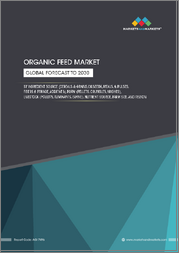
|
시장보고서
상품코드
1700114
세계의 시리얼 디스펜서 및 건조 식품 디스펜서 시장 : 제품별, 소재별, 유통 채널별, 용도별, 지역별 분석 및 예측(-2032년)Cereal Dispensers and Dry Food Dispensers Market Forecasts to 2032 - Global Analysis by Product (Wall-Mounted Dispensers, Countertop Dispensers and Floor-Standing Dispensers), Material, Distribution Channel, Application and By Geography |
||||||
Stratistics MRC에 따르면 세계의 시리얼 디스펜서 및 건조 식품 디스펜서 시장은 2025년 10억 3,700만 달러를 차지하며 예측 기간 동안 CAGR 8.5%를 나타내 2032년까지 18억 3,560만 달러에 이를 것으로 예상되고 있습니다.
시리얼 디스펜서 및 건조 식품 디스펜서는 건조 식품를 신선하게 유지해, 간단하게 이용할 수 있도록 설계된 보관·분배 유닛입니다. 시리얼 디스펜서는 특히 아침식사용 시리얼을 위해서 만들어져, 쏟아지는 것을 막고 파리로 한 식감을 유지하기 위해, 밀폐 용기와 분량 제어의 디스펜서 기구 징입니다. 한편, 건조 식품 디스펜서는 쌀, 파스타, 견과류, 캔디, 반려동물 푸드 등, 다양한 건조 상품에 대응하는 보다 범용성이 높은 것입니다.
위생적인 식품 저장 솔루션에 대한 수요 증가
시리얼 디스펜서 및 건조 식품 디스펜서 시장은 위생적인 식품 보존 솔루션에 대한 요구가 증가하고 있습니다. 비용은 터치리스, 기밀성, BPA 프리 디스펜서 등의 기술 혁신에 대응하고 있습니다.위생법의 엄격화, 식품 안전에 대한 관심 증가, 카페테리아, 레스토랑, 호텔에서의 셀프서비스식 푸드 스테이션의 대두는 모두, 편리성의 향상과 식품 폐기의 삭감에 의해 시장의 확대에 기여하고 있습니다.
높은 초기 비용
시리얼 디스펜서 및 건조 식품 디스펜서의 초기 비용이 높은 것은 특히 중소기업과 비용에 민감한 소비자에게 시장 성장의 큰 장벽이 되고 있습니다. 비용을 밀어 올리고 소매 가격 상승으로 이어지므로 예산에 중점을 둔 구매 의욕이 줄어들고 보급이 제한됩니다.
정리된 식품 보관고의 인기 증가
정리된 식품 저장의 인기가 높아 시리얼 디스펜서 및 건조 식품 디스펜서 시장 수요를 견인하고 있습니다. 라이프 스타일의 동향에 부합합니다. 게다가 포션 컨트롤과 지속가능성에 대한 의식의 고조가 가정, 호텔, 레스토랑에서의 디스펜서 채용을 뒷받침하고 있습니다.
내구성과 유지보수 문제
내구성과 유지 보수 문제는 시리얼 디스펜서 및 건조 식품 디스펜서 시장의 성장을 크게 방해합니다. 과 기업은 오래 지속되고 유지 보수가 적은 솔루션을 요구하는 경우가 많으며, 신뢰성이 낮은 디스펜서는 매력이 부족합니다. 또한 내구성이 낮으면 빈번한 교환을 초래하여 운용 비용을 증가시키고 대량 구매를 억제하며 궁극적으로 시장의 확대와 보급을 억제합니다.
COVID-19의 영향
COVID-19의 대유행은 위생 우려 증가와 고객 행동의 변화로 시리얼 디스펜서 및 건조 식품 디스펜서 시장에 큰 영향을 미쳤습니다. 탈퇴로 매출이 늘어났지만 비접촉형 디스펜서 옵션에 대한 인식이 높아진 결과 시장은 회복되었습니다.
예측기간 중 카운터탑형 디스펜서 분야가 최대가 될 전망
카운터 탑형 디스펜서는 상업 공간이나 주택 공간에 대응하고 식품의 보존을 강화하고 폐기물을 삭감하기 때문에 예측 기간 동안 이 분야가 최대 시장 점유율을 차지할 것으로 예상됩니다. 아에서 수요가 높아지고, 신선하고 간단하게 얻을 수 있는 시리얼이나 건조 식품를 요구하는 건강 지향의 소비자 증가가 채용을 뒷받침하고 있습니다. 또한, 소재나 디자인의 혁신이 내구성과 미관을 향상시켜, 시장의 성장을 한층 더 밀어주고 있습니다.
예측 기간 동안 CAGR이 가장 높을 것으로 예상되는 유리 부문
예측 기간 동안 미적 매력, 내구성, 위생적 특성으로 인해 유리 부문이 가장 높은 성장률을 보일 것으로 예측됩니다. 무용이나 가정용으로서 이상적입니다.이 분야는 지속 가능하고 리사이클 가능한 소재에 대한 수요의 높아로부터 혜택을 받고 있어 환경 의식이 높은 소비자의 기호에 합치하고 있습니다. 또, 고급감이 있기 때문에 하이엔드의 접객업이나 소매업에도 적합하고, 시장의 보급을 뒷받침하고 있습니다.
최대 점유율을 차지하는 지역 :
예측 기간 동안, 아시아태평양은 도시화의 진전, 식품 보존의 편의성에 대한 수요 증가, 호텔, 레스토랑, 카페테리아에서의 채용 확대에 의해 최대 시장 점유율을 차지할 것으로 예상됩니다. 건조 식품 디스펜서를 선호하는 건강 지향 소비자의 급증은 시장 성장을 더욱 뒷받침하고 있습니다.
CAGR이 가장 높은 지역 :
예측 기간 동안 북미는 가장 높은 CAGR을 나타낼 것으로 예측됩니다. 이는 가정, 호텔, 외식 산업에서 위생적이고 분량이 관리되는 식품 보존 솔루션에 대한 수요가 있기 때문입니다. 터치리스 디스펜서 등의 기술적 진보는 상업 공간에서의 매력을 높이고 있습니다.
무료 사용자 지정 오퍼링 :
이 보고서를 구독하는 고객에게 다음 무료 맞춤설정 옵션 중 하나를 제공합니다.
- 기업 프로파일
- 추가 시장 기업의 종합적 프로파일링(3개사까지)
- 주요 기업의 SWOT 분석(3개사까지)
- 지역 세분화
- 고객의 관심에 응한 주요국 시장 추계·예측·CAGR(주 : 타당성 확인에 따름)
- 경쟁 벤치마킹
- 제품 포트폴리오, 지리적 존재, 전략적 제휴에 기반한 주요 기업 벤치마킹
목차
제1장 주요 요약
제2장 서문
- 개요
- 이해관계자
- 조사 범위
- 조사 방법
- 데이터 마이닝
- 데이터 분석
- 데이터 검증
- 조사 접근
- 조사 자료
- 1차 조사 자료
- 2차 조사 정보원
- 전제조건
제3장 시장 동향 분석
- 성장 촉진요인
- 성장 억제요인
- 기회
- 위협
- 제품분석
- 용도 분석
- 신흥 시장
- COVID-19의 영향
제4장 Porter's Five Forces 분석
- 공급기업의 협상력
- 구매자의 협상력
- 대체품의 위협
- 신규 참가업체의 위협
- 경쟁 기업간 경쟁 관계
제5장 세계의 시리얼 디스펜서 및 건조 식품 디스펜서 시장 : 제품별
- 벽걸이형 디스펜서
- 카운터탑 디스펜서
- 플로어 스탠딩 디스펜서
제6장 세계의 시리얼 디스펜서 및 건조 식품 디스펜서 시장 : 소재별
- 플라스틱
- 금속
- 유리
- 기타 소재
제7장 세계의 시리얼 디스펜서 및 건조 식품 디스펜서 시장 : 유통 채널별
- 온라인 소매
- 슈퍼마켓 및 하이퍼마켓
- 편의점
제8장 세계의 시리얼 디스펜서 및 건조 식품 디스펜서 시장 : 용도별
- 주거
- 상업
- 산업
제9장 세계의 시리얼 디스펜서 및 건조 식품 디스펜서 시장 : 지역별
- 북미
- 미국
- 캐나다
- 멕시코
- 유럽
- 독일
- 영국
- 이탈리아
- 프랑스
- 스페인
- 기타 유럽
- 아시아태평양
- 일본
- 중국
- 인도
- 호주
- 뉴질랜드
- 한국
- 기타 아시아태평양
- 남미
- 아르헨티나
- 브라질
- 칠레
- 기타 남미
- 중동 및 아프리카
- 사우디아라비아
- 아랍에미리트(UAE)
- 카타르
- 남아프리카
- 기타 중동 및 아프리카
제10장 주요 발전
- 계약, 파트너십, 협업, 합작투자
- 인수와 합병
- 신제품 발매
- 사업 확대
- 기타 주요 전략
제11장 기업 프로파일링
- Zevro
- OXO Good Grips
- Honey-Can-Do International
- Rosseto
- Buddeez
- VISTA ALEGRE
- Progressive International
- Anchor Hocking
- Mind Reader
- Brabantia
- Gruppo Fabbri
- Kuban
- Eastern Tabletop
- Cal-Mil
- Rishab Hotel & Restaurant Services Pvt. Ltd.
- Sterling Polychem
- Shanghai Fude Machinery Manufacturing Co., Ltd.
- Hindustan Soda Dispenser
According to Stratistics MRC, the Global Cereal Dispensers and Dry Food Dispensers Market is accounted for $1,037.0 million in 2025 and is expected to reach $1,835.6 million by 2032 growing at a CAGR of 8.5% during the forecast period. Cereal dispensers and dry food dispensers are storage and dispensing units designed to keep dry food items fresh and easily accessible. Cereal dispensers are specifically made for breakfast cereals, featuring airtight containers and portion-controlled dispensing mechanisms to prevent spills and maintain crispness. Dry food dispensers, on the other hand, are more versatile, accommodating a range of dry goods such as rice, pasta, nuts, candy, and pet food. They come in various sizes and styles, including wall-mounted, countertop, and gravity-fed models, ensuring convenience and hygiene while reducing food waste.
Market Dynamics:
Driver:
Growing Demand for Hygienic Food Storage Solutions
The market for cereal dispensers and dry food dispensers is mostly driven by the rising need for hygienic food storage solutions. Extended shelf life, portion control, and contamination-free storage are becoming more and more important to consumers and food service providers. Health-conscious consumers are catered to by innovations including touchless, airtight, and BPA-free dispensers. Stricter hygiene laws, growing food safety concerns, and the rise of self-serve food stations in cafeterias, restaurants, and hotels all contribute to the market's increase by improving convenience and cutting down on food waste.
Restraint:
High Initial Cost
The high initial cost of cereal dispensers and dry food dispensers acts as a significant barrier to market growth, particularly for small businesses and cost-sensitive consumers. Premium materials advanced dispensing mechanisms, and smart technology integration drive up manufacturing expenses, leading to higher retail prices. This discourages budget-conscious buyers, limiting widespread adoption. Additionally, businesses may hesitate to invest in dispensers due to prolonged ROI, further hindering market expansion.
Opportunity:
Rising Popularity of Organized Food Storage
The rising popularity of organized food storage is driving demand in the cereal dispensers and dry food dispensers market. Consumers are increasingly seeking efficient, space-saving, and hygienic storage solutions to maintain food freshness and reduce waste. Organized storage enhances kitchen aesthetics, aligning with modern lifestyle trends. Additionally, growing awareness of portion control and sustainability is boosting dispenser adoption in households, hotels, and restaurants. This trend is further supported by innovations in design and materials, catering to both residential and commercial needs.
Threat:
Durability and Maintenance Issues
Durability and maintenance issues significantly hinder the growth of the cereal dispensers and dry food dispensers market. Frequent wear and tear, mechanical failures, and hygiene concerns lead to higher maintenance costs and reduced product lifespan. Consumers and businesses often seek long-lasting, low-maintenance solutions, making unreliable dispensers less appealing. Additionally, poor durability results in frequent replacements, increasing operational costs and discouraging bulk purchases, ultimately restraining market expansion and adoption.
Covid-19 Impact
The COVID-19 pandemic had a substantial impact on the cereal dispensers and dry food dispensers market, owing to increased hygiene concerns and changes in customer behaviour. Sales were originally hindered by foodservice closures and a decline in demand from the hospitality industry, but the market recovered as a result of growing awareness of contactless dispensing options. Demand was increased by growing use in self-serve settings, hotels, and commercial kitchens.
The countertop dispensers segment is expected to be the largest during the forecast period
The countertop dispensers segment is expected to account for the largest market share during the forecast period, as these dispensers cater to commercial and residential spaces, enhancing food storage and reducing waste. Rising demand in hotels, restaurants, and cafeterias, along with growing health-conscious consumers seeking fresh and easy-access cereals or dry foods, boosts adoption. Additionally, innovations in materials and designs improve durability and aesthetics, further propelling market growth.
The glass segment is expected to have the highest CAGR during the forecast period
Over the forecast period, the glass segment is predicted to witness the highest growth rate due to its aesthetic appeal, durability, and hygienic properties. Consumers prefer glass dispensers for their non-toxic, BPA-free nature, ensuring food safety. Additionally, glass enhances product visibility, making it ideal for commercial and household applications. The segment is benefiting from the rising demand for sustainable and recyclable materials, aligning with eco-conscious consumer preferences. Its premium feel also caters to high-end hospitality and retail sectors, boosting market adoption.
Region with largest share:
During the forecast period, the Asia Pacific region is expected to hold the largest market share because of increasing urbanization, rising demand for convenience in food storage, and growing adoption in hotels, restaurants, and cafeterias. The surge in health-conscious consumers preferring portion control and hygienic food dispensing solutions further fuels market growth. Additionally, the expansion of the hospitality and food service industry, coupled with technological advancements in smart dispensers, supports market penetration.
Region with highest CAGR:
Over the forecast period, the North America region is anticipated to exhibit the highest CAGR, owing to demand for hygienic, portion-controlled food storage solutions in homes, hotels, and food service industries. Growing health consciousness and preference for convenient, organized kitchen setups fuel market growth. Technological advancements, such as touch less dispensers, enhance appeal in commercial spaces. The expansion of the hospitality sector and increasing adoption in cafeterias, schools, and offices further boosts demand.
Key players in the market
Some of the key players profiled in the Cereal Dispensers and Dry Food Dispensers Market include Zevro, OXO Good Grips, Honey-Can-Do International, Rosseto, Buddeez, VISTA ALEGRE, Progressive International, Anchor Hocking, Mind Reader, Brabantia, Gruppo Fabbri, Kuban, Eastern Tabletop, Cal-Mil, Rishab Hotel & Restaurant Services Pvt. Ltd., Sterling Polychem, Shanghai Fude Machinery Manufacturing Co., Ltd. and Hindustan Soda Dispenser.
Key Developments:
In June 2024, OXO in association with local Australian Distributor Sheldon & Hammond Pty Ltd announced the launch of OXO Outdoor for the Australian market. Expanding OXO's portfolio of tools and gadgets to the outdoors, the line brings the durability and thoughtful, universal design of OXO's iconic cooking and cleaning products to create better outdoor adventure cooking and cleaning experiences.
In February 2024, Brabantia and Curve Distribution Services announced that the companies have entered a valuable distribution partnership where Curve will bring Brabantia's product line of housewares to the Canadian market.
Products Covered:
- Wall-Mounted Dispensers
- Countertop Dispensers
- Floor-Standing Dispensers
Materials Covered:
- Plastic
- Metal
- Glass
- Other Materials
Distribution Channels Covered:
- Online Retail
- Supermarkets and Hypermarkets
- Convenience Stores
Applications Covered:
- Residential
- Commercial
- Industrial
Regions Covered:
- North America
- US
- Canada
- Mexico
- Europe
- Germany
- UK
- Italy
- France
- Spain
- Rest of Europe
- Asia Pacific
- Japan
- China
- India
- Australia
- New Zealand
- South Korea
- Rest of Asia Pacific
- South America
- Argentina
- Brazil
- Chile
- Rest of South America
- Middle East & Africa
- Saudi Arabia
- UAE
- Qatar
- South Africa
- Rest of Middle East & Africa
What our report offers:
- Market share assessments for the regional and country-level segments
- Strategic recommendations for the new entrants
- Covers Market data for the years 2024, 2025, 2026, 2028, and 2032
- Market Trends (Drivers, Constraints, Opportunities, Threats, Challenges, Investment Opportunities, and recommendations)
- Strategic recommendations in key business segments based on the market estimations
- Competitive landscaping mapping the key common trends
- Company profiling with detailed strategies, financials, and recent developments
- Supply chain trends mapping the latest technological advancements
Free Customization Offerings:
All the customers of this report will be entitled to receive one of the following free customization options:
- Company Profiling
- Comprehensive profiling of additional market players (up to 3)
- SWOT Analysis of key players (up to 3)
- Regional Segmentation
- Market estimations, Forecasts and CAGR of any prominent country as per the client's interest (Note: Depends on feasibility check)
- Competitive Benchmarking
- Benchmarking of key players based on product portfolio, geographical presence, and strategic alliances
Table of Contents
1 Executive Summary
2 Preface
- 2.1 Abstract
- 2.2 Stake Holders
- 2.3 Research Scope
- 2.4 Research Methodology
- 2.4.1 Data Mining
- 2.4.2 Data Analysis
- 2.4.3 Data Validation
- 2.4.4 Research Approach
- 2.5 Research Sources
- 2.5.1 Primary Research Sources
- 2.5.2 Secondary Research Sources
- 2.5.3 Assumptions
3 Market Trend Analysis
- 3.1 Introduction
- 3.2 Drivers
- 3.3 Restraints
- 3.4 Opportunities
- 3.5 Threats
- 3.6 Product Analysis
- 3.7 Application Analysis
- 3.8 Emerging Markets
- 3.9 Impact of Covid-19
4 Porters Five Force Analysis
- 4.1 Bargaining power of suppliers
- 4.2 Bargaining power of buyers
- 4.3 Threat of substitutes
- 4.4 Threat of new entrants
- 4.5 Competitive rivalry
5 Global Cereal Dispensers and Dry Food Dispensers Market, By Product
- 5.1 Introduction
- 5.2 Wall-Mounted Dispensers
- 5.3 Countertop Dispensers
- 5.4 Floor-Standing Dispensers
6 Global Cereal Dispensers and Dry Food Dispensers Market, By Material
- 6.1 Introduction
- 6.2 Plastic
- 6.3 Metal
- 6.4 Glass
- 6.5 Other Materials
7 Global Cereal Dispensers and Dry Food Dispensers Market, By Distribution Channel
- 7.1 Introduction
- 7.2 Online Retail
- 7.3 Supermarkets and Hypermarkets
- 7.4 Convenience Stores
8 Global Cereal Dispensers and Dry Food Dispensers Market, By Application
- 8.1 Introduction
- 8.2 Residential
- 8.3 Commercial
- 8.4 Industrial
9 Global Cereal Dispensers and Dry Food Dispensers Market, By Geography
- 9.1 Introduction
- 9.2 North America
- 9.2.1 US
- 9.2.2 Canada
- 9.2.3 Mexico
- 9.3 Europe
- 9.3.1 Germany
- 9.3.2 UK
- 9.3.3 Italy
- 9.3.4 France
- 9.3.5 Spain
- 9.3.6 Rest of Europe
- 9.4 Asia Pacific
- 9.4.1 Japan
- 9.4.2 China
- 9.4.3 India
- 9.4.4 Australia
- 9.4.5 New Zealand
- 9.4.6 South Korea
- 9.4.7 Rest of Asia Pacific
- 9.5 South America
- 9.5.1 Argentina
- 9.5.2 Brazil
- 9.5.3 Chile
- 9.5.4 Rest of South America
- 9.6 Middle East & Africa
- 9.6.1 Saudi Arabia
- 9.6.2 UAE
- 9.6.3 Qatar
- 9.6.4 South Africa
- 9.6.5 Rest of Middle East & Africa
10 Key Developments
- 10.1 Agreements, Partnerships, Collaborations and Joint Ventures
- 10.2 Acquisitions & Mergers
- 10.3 New Product Launch
- 10.4 Expansions
- 10.5 Other Key Strategies
11 Company Profiling
- 11.1 Zevro
- 11.2 OXO Good Grips
- 11.3 Honey-Can-Do International
- 11.4 Rosseto
- 11.5 Buddeez
- 11.6 VISTA ALEGRE
- 11.7 Progressive International
- 11.8 Anchor Hocking
- 11.9 Mind Reader
- 11.10 Brabantia
- 11.11 Gruppo Fabbri
- 11.12 Kuban
- 11.13 Eastern Tabletop
- 11.14 Cal-Mil
- 11.15 Rishab Hotel & Restaurant Services Pvt. Ltd.
- 11.16 Sterling Polychem
- 11.17 Shanghai Fude Machinery Manufacturing Co., Ltd.
- 11.18 Hindustan Soda Dispenser



















